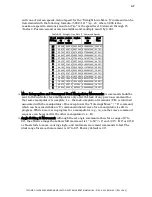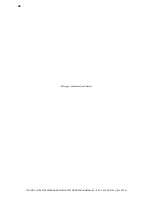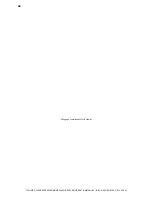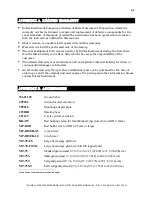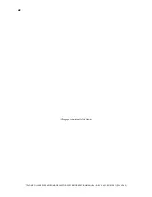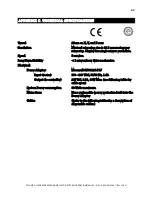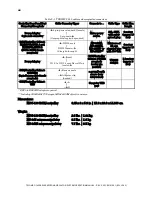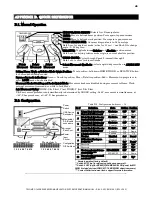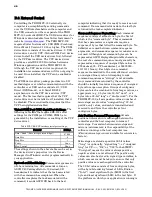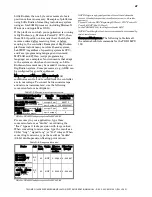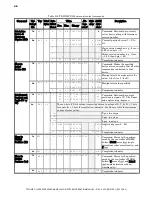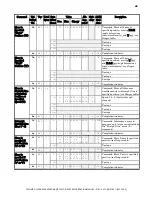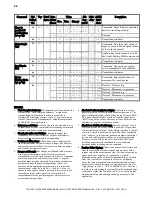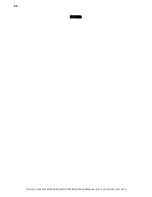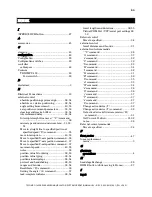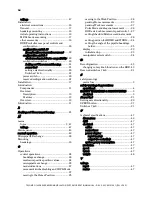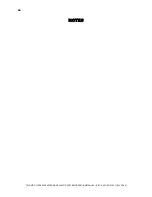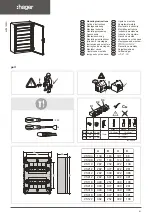
TRIO MPC-145 SERIES MICROMANIPULATOR SYSTEM OPERATION MANUAL – REV. 2.62C (20191001) (FW V2.62)
51
9.
Position Value Bit Ordering: All 32-bit position values
transmitted to, and received from, the controller must be
bit/byte-ordered in “Little Endian” format. This means that
the least significant bit/byte is last (last to send and last to
receive). Byte-order reversal may be required on some
platforms. Microsoft Windows, Intel-based Apple Macintosh
systems running Mac OS X, and most Intel/AMD processor-
based Linux distributions handle byte storage in Little-
Endian byte order so byte reordering is not necessary before
converting to/from 32-bit “long” values. LabVIEW always
handles “byte strings” in “Big Endian” byte order
irrespective of operating system and CPU, requiring that the
four bytes containing a microsteps value be reverse ordered
before/after conversion to/from a multibyte type value (I32,
U32, etc.). MATLAB automatically adjusts the endianess of
multibyte storage entities to that of the system on which it is
running, so explicit byte reordering is generally unnecessary
unless the underlying platform is Big Endian. If your
development platform does not have built-in Little/Big
Endian conversion functions, bit reordering can be
accomplished by first swapping positions of the two bytes in
each 16-bit half of the 32-bit value, and then swap positions
of the two halves. This method efficiently and quickly
changes the bit ordering of any multibyte value between the
two Endian formats (if Big Endian, it becomes Little Endian,
and if Little Endian, it becomes then Big Endian).
10.
Travel Lengths and Durations: “Move” commands might
have short to long distances of travel. If not polling for return
data, an appropriate delay should be inserted between the
sending of the command sequence and reception of return
data so that the next command is sent only after the move is
complete. This delay can be auto calculated by determining
the distance of travel (difference between current and target
positions) and rate of travel. This delay is not needed if
polling for return data. In either case, however, an
appropriate timeout must be set for the reception of data so
that the I/O does not time out before the move is made and/or
the delay expires.
11.
Movement Speeds: All move commands cause movement to
occur at a rate of 5,000 microns/second, except for the
“Straight-Line Move ‘S’ command which can be specified
with one of sixteen speeds. Actual speed for the “Straight-
Line Move ‘S’ command can be determined with the
following formula: (5000 / 16) * (sp +1), where 5,000 is the
maximum speed in microns/second and “sp” is the speed level
0 (slowest) through 15 (fastest). For mm/second or
microns/millisecond, multiply result by 0.001.
Table
D-6
. Straight-Line Move ‘S’ Command Speeds.
Speed
Setting
mm/sec
or
µm/ms
µm/sec
or
nm/ms
nm/sec
in/sec
or
mil/ms
% of
Max.
15
5.0000 5000.0 5000000 0.196850394 100.00%
14
4.6875 4687.5 4687500 0.184547244 93.75%
13
4.3750 4375.0 4375000 0.172244094 87.50%
12
4.0625 4062.5 4062500 0.159940945 81.25%
11
3.7500 3750.0 3750000 0.147637795 75.00%
10
3.4375 3437.5 3437500 0.135334646 68.75%
9
3.1250 3125.0 3125000 0.123031496 62.50%
8
2.8125 2812.5 2812500 0.110728346 56.25%
7
2.5000 2500.0 2500000 0.098425197 50.00%
6
2.1875 2187.5 2187500 0.086122047 43.75%
5
1.8750 1875.0 1875000 0.073818898 37.50%
4
1.5625 1562.5 1562500 0.061515748 31.25%
3
1.2500 1250.0 1250000 0.049212598 25.00%
2
0.9375 0937.5 937500 0.036909449 18.75%
1
0.6250 0625.0 625000 0.024606299 12.50%
12.
Move Interruption and Concurrent Dual Manipulator
Movements: A command should be sent to the controller for
a manipulator only after the task of any previous command
for that same manipulator is complete (i.e., the task-
completion terminator (CR) is returned associated with the
manipulator). One exception is the “Interrupt Move” (^C)
command, which can be issued while an ‘S’ command-
initiated move for a manipulator is still in progress. While a
move is in progress for a manipulator (e.g., A), another move
command sequence can be issued for the other manipulator
(i.e., B).
13.
Angle Setting & Movement: Although the set angle command
allows for a range of 0° to 90°, the effective range that allows
full movement is 1° to 89° (>0° and <90°). If 0° or 90°, Z or X
axis fails to move, causing single- and multi-axis movement
commands to fail. The ideal range for smooth movement is
10° to 80°. Factory default is 30°.
NOTES:

